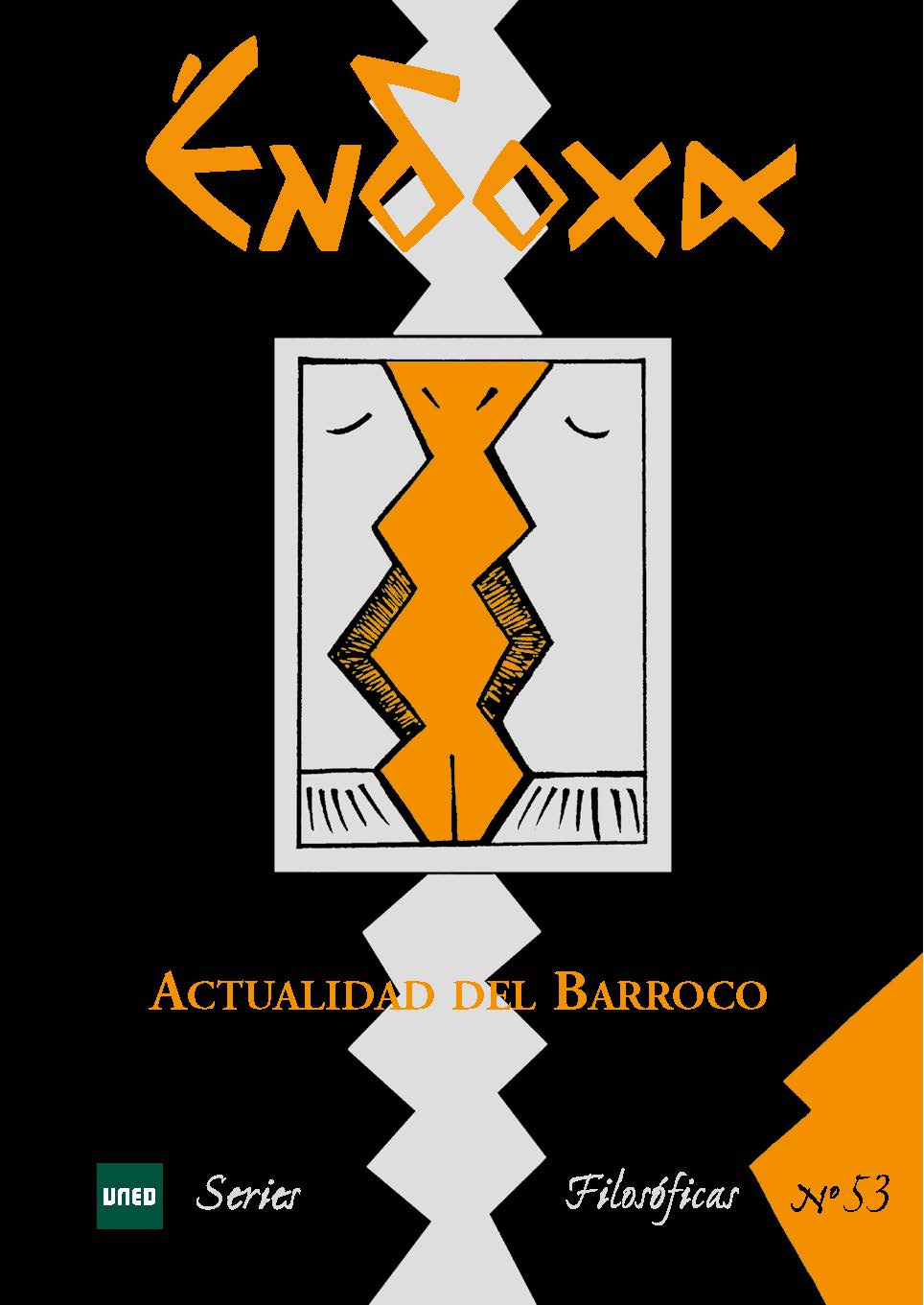Specters of the Baroque. Tenebrism, hyperbole and fantology in the deconstruction of Jacques Derrida
DOI:
https://doi.org/10.5944/endoxa.53.2024.38081Keywords:
Baroque, deconstruction, tenebrism, hyperbole, fantologyAbstract
The present study seeks to establish the internal relationship between the Baroque movement and its neo-Baroque update with the deconstruction of Jacques Derrida. For this, we will analyze, first, the nucleus of absence that runs through Derrida's thought in three aspects: absence of meaning, absence of identity (self) and absence or substraction of otherness. As will be seen, all three remain related to the idea of deus absconditus through the influence of Pascal, giving rise to what we will call deconstructive tenebrism. Secondly, we will resort to Severo Sarduy to account for the hyperbolization that deconstruction carries out of fundamental characteristics of the baroque and neo-baroque thematized by the Cuban thinker (substitution, proliferation and condensation). Finally, we will give an account of the concept of fantology (hantologie) that Derrida brings in various texts and in which a theatrical spectrality also typical of the baroque and neo-baroque is shown. We will conclude delving into the hyperbole, already mentioned, but in political-moral terms, that is, the neo-baroque of deconstruction would be nothing more than the tragic demand for the necessary impossible: justice, since injustice is inevitable.
Downloads
References
AYALA MARTÍNEZ, Jorge Manuel (2004). "Ingenio, causa principal de la agudeza y complemento del juicio", en Conceptos. Revista de Investigación Graciana, vol. 1., pp. 115-132.
DELEUZE, Gilles (1989). El pliegue. Leibniz y el barroco. Barcelona: Paidós.
DERRIDA, Jacques (2017). Psyché. Invenciones del otro. Argentina: La cebra.
— (2012). Espectros de Marx. El estado de la deuda, el trabajo del duelo y la nueva internacional, Madrid: Trotta.
— (2009). "¿Cómo no temblar?", en Acta poética, Revista del Instituto de Investigaciones Filológicas de la Universidad Nacional Autónoma de México (UNAM), vol. 30, nº 2.
— (2008). Fuerza de ley. El “fundamento místico de la autoridad”, Madrid: Tecnos.
— (2003). “Autoinmunidad: suicidios simbólicos y reales. Diálogo con Jacques Derrida (octubre de 2001)”, en Barrodori, G (ed.), La filosofía en una época de terror. Diálogos con J.Habermas y J. Derrida, Madrid: Taurus.
— (2001). La verdad en pintura, Buenos Aires: Paidós.
— (2000). Dar la muerte, Barcelona: Paidós.
— (1998). Políticas de la amistad seguido de El oído de Heidegger, Madrid: Trotta.
— (1997). La diseminación, Madrid: Fundamentos.
— (1995). Dar (el) tiempo. I. La moneda falsa, Barcelona: Paidós.
— (1989a). La escritura y la diferencia, Barcelona: Anthropos.
— (1989b). La deconstrucción en las fronteras de la filosofía, Barcelona: Paidós.
— (1988). Márgenes de la filosofía, Madrid: Cátedra.
— (1985). La voz y el fenómeno, Valencia: Pre-Textos.
— (1971). De la gramatología, Buenos Aires, Argentina: Siglo XXI.
GRANDE YAÑEZ Miguel (2022). "La vida, el desengaño y el ingenio en el Barroco español", en Mora, J.L./Heredia, A. (eds)., Guía Comares de Historia de la Filosofía Española, Granada: Comares.
HABERMAS, Jurgën (1985; 2008). El discurso filosófico de la modernidad, Buenos Aires, Argentina: Katz.
KIERKEGAARD, Sören (2014). Temor y temblor, Madrid: Alianza.
— (2011). Para un examen de sí mismo recomendado a este tiempo, Madrid: Trotta.
MARTÍNEZ, Francisco José (2014). Próspero en el laberinto. Las dos caras del Barroco, Madrid: Dykinson.
PASCAL, Blaise (2012). Las provinciales, Opúsculos, Cartas, Pensamientos, Obras matemáticas, Obras físicas, Vida de Monsieur Pascal, Conversación con Monsieur de Saci, Madrid: Gredos.
ROUSSET, Jean (2009). Circe y el pavo real. La literatura del barroco en Francia. Barcelona: Acantilado.
SÁEZ RUEDA, Luis (2022a). "Verdad y diferencia en el Barroco hispano como «modernidad-otra»", en Pensamiento. Revista de investigación e información filosófica, vol. 78 (300 Extra), pp. 1259-12.
— (2022b). "El límite trágico entre lo inmundo y lo eterno en el Barroco hispano", en Hipogrifo: Revista de Literatura y Cultura del Siglo de Oro, vol. 10, nº2, pp. 191-206.
SEVERO, Sarduy (1984). "El barroco y el neobarroco", en Moreno Fernández, C., (coord.), América Latina en la literatura, México: s. XXI.
— (1987): «Barroco», en Ensayos generales sobre el barroco, Buenos Aires: F. C. E.
Downloads
Published
How to Cite
Issue
Section
License

This work is licensed under a Creative Commons Attribution-NonCommercial-NoDerivatives 4.0 International License.
The authors who publish in this journal must agree to the following terms:
- The authors hold author’s rights and guarantee the journal the right to be the first to publish the work as well as the Creative Commons Attribution License which allows others to share the work as long as they acknowledge the authorship of the work and its initial publication in this journal.
- The authors can establish, on their own, additional agreements for the non-exclusive distribution of the version of the work published in the journal (for example, placing it in an institutional repository or publishing it in a book), always acknowledging the initial publication in this journal.
- The authors are allowed and encouraged to disseminate their work electronically (for example, in institutional repositories or on their own webpages) before and during the submission process, as this can give rise to productive exchanges, as well as earlier and increased citing of the works published (See The Effect of Open Access).







